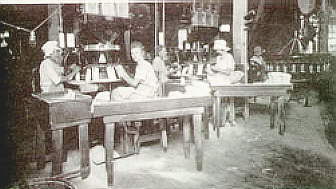The second method of salt production used by Morton Salt is mining. The mining of rock salt is the second oldest form of salt production.
Underground mining is probably the most dramatic method of producing salt. Large machines travel through vast cave-like passageways performing various operations. Salt mines are among the safest of mines. They are also the most comfortable to work in. While mine temperatures vary within depth, the average temperature remains about 70 year-round.
Salt may appear in veins like coal. Veins are the original bedded salt deposits. Salt may also be found in domes. Salt domes were formed when earth pressures forced salt up through cracks from depths as great as 30,000 or 40,000 feet. Domes are roughly like plugs of almost circular shape a few hundred yards to a mile across. Some domes occur at shallow depths, Both domes and veins are mined in a similar way.
To enter a salt mine miners dig down a shaft from the earth's surface to the salt bed. There are two shafts in each Morton Mine - one for personnel and one to lower materials and equipment into the mine, and to hoist up the mined rock salt. Shafts are usually circular and about 12 to 18 feet across. Most mine shafts are lined with a concrete wall.
Salt is mined by the room and pillar method. Salt is removed in a checkerboard pattern to leave permanent solid salt pillars for roof support. Usually from 45 to 65 percent of the salt is removed. The room height may average from 8 feet in a bed to 90 feet in a dome.
Normally, the first operation is undercutting. Electrically driven machines cut a slot 10 or more feet in depth across the bottom of a solid wall. This leaves a smooth floor for picking up the salt after blasting.
Next, small holes are drilled into the salt wall to a depth of 10 or more feet. Explosives are tamped into the drilled holes. After the work shift, the explosives are set off electrically. Several hundred tons of rock salt are blasted and fall onto the mine floor.
A front-end loader picks up the salt and places it into a truck. The truck hauls the salt to a combination crusher and feeder, which puts it onto a conveyor belt. The rock salt discharged from the crusher is then conveyed to a series of below-ground crushing and screening stations for additional sizing of the lumps, and then to a storage bin. The salt is then ready to be hoisted to the surface as required.
Hoisting is accomplished by means of skips [large holding bins] which are filled with salt from the storage bin by mechanically operated weighing or measuring chutes and conveyors. The skips are raised and lowered within the shaft by steel cables, which wind over pulleys. After the skip of salt is hoisted aboveground, the salt is conveyed to bins or silos for further processing.
The aboveground processing of the rock salt consists of sorting the mined salt into various marketable sizes by screening over mechanically operated screen. When separated, each size is conveyed to its individual bulk storage bin to await packaging for shipment, or to be loaded as bulk salt into railroad cars, trucks, river barges or lake boats for shipment to customers. Other than the Grand Saline plant Morton Salt has mining operations as (sic) Weeks Island, Louisiana and Fairport, Ohio.
Additions, corrections, comments, complaints and compliments concerning this page should be submitted to Billy & Carla Clifton.
The photos on this page were furnished by the Van Zandt County Historical Commission reproduced with their permission from Van Zandt County Pictorial History 1848-1994.

